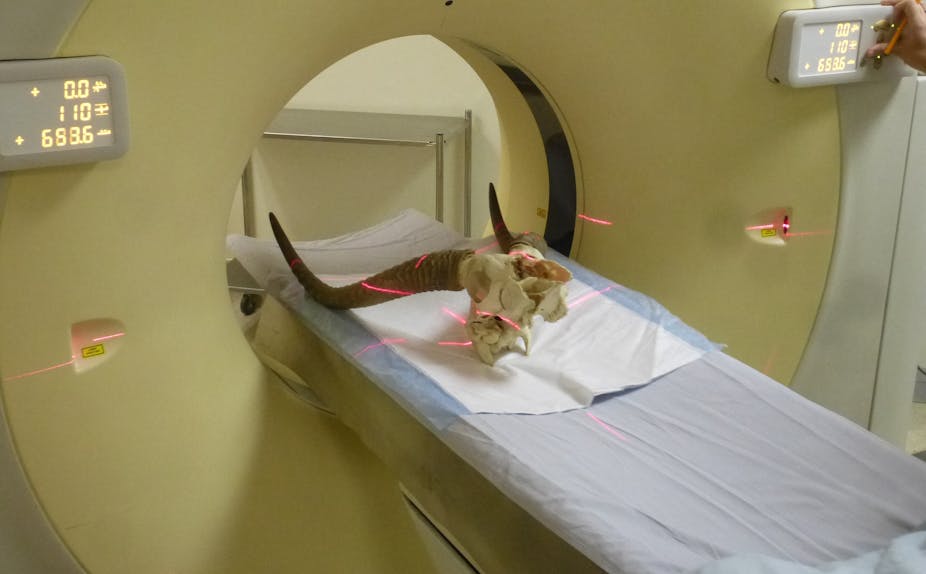For more than a century anthropologists, zoologists and palaeontologists have used a small but important part of the anatomy to reconstruct the head posture of both extinct and existing species. This is important because head posture allows scientists to hypothesise about other things such as diet and how species moved.
The body part in question is the plane of the lateral semicircular canal of the inner ear. This is a small canal in the skull that belongs to the organ of balance. All vertebrates from fish to dinosaurs have it. Since the early 1900s, researchers have assumed that the plane of this canal was held parallel to the Earth’s horizontal plane.
So, they reasoned, placing a fossil skull with its lateral semicircular inner ear canal parallel to the Earth’s horizontal plane would reveal how extinct species held their heads. Inner ears preserve very well in the fossil record, which made this technique easy to use on a wide variety of extinct animals.
But the assumption that the lateral semicircular canal is held horizontal was never actually tested on living animals. Three years ago, an international team led by researchers from the University of the Witwatersrand in South Africa decided to put the hypothesis to the test. The resulting study, just published in the journal Scientific Reports, disproves the 100-year-old theory.
We found that the lateral semicircular canal is not normally held horizontally. This means that reconstructing head posture is not simply a matter of aligning the lateral canal with the horizontal plane, and that head posture has a much more complicated evolutionary story. This has major implications for our understanding of the evolution of life: head posture has been used as a gateway to, for example, bipedalism in hominins, diet in herbivores (browsers are believed to hold their head higher up than grazers do), and even the origin of warm-bloodedness in dinosaurs.
A gargantuan task
The work that resulted in this study started three years ago when I began putting together a comprehensive dataset that sought to answer a deceptively simple question: “Is the lateral semicircular canal of the inner ear a reliable proxy to infer head posture?”
In theory, finding answers would be easy. I would simply have to observe live animals and compare the posture of their head as reconstructed using the lateral semicircular canal to their actual head posture to see if the two matched.
But in practice, it was no easy task. To access the lateral canal, my collaborators and I had to put over 300 mammalian skulls from around the world into X-ray medical scanners. The inner ear then had to be extracted digitally from the X-ray images. In parallel, we had to photographically document the actual head posture of the same species using a camera equipped with a bubble level to ensured that all pictures would be taken horizontally. To do this, I travelled to zoos on three different continents to create the largest photographic dataset of head posture in mammals: it contains more than 10 000 pictures of animals, in profile, ranging from giraffes to African and Indian rhinos, horses, zebras, pigs, a huge variety of antelopes and hippos.
Thanks to this dataset, we could compare the actual and reconstructed head posture in more than a hundred species of mammals.
Examining the data
Next, I took the X-ray images to the computers at Wits University, extracted the inner ear from the skull digitally and reconstructed it in 3D using modeling software.
Then I measured the angle between the skull and the lateral semicircular canal (many times to cover measurement errors). I did this for every single specimen that was scanned - a process that took months. In parallel, I took the pictures of the living animals and measured the angle between the head and the horizontal plane.

Finally, I compared the two measurements. If the canal was held parallel to the Earth’s horizontal plane, the angles I measured on the skull and the living animals would be the same, on average.
But they were not. Some species, such as the hippos, display an up to 39° difference between the two measurements. We also found that ecology (diet and habitat) have little to do with head posture. In fact, head posture appears to be simply driven by genetics: closely related species on the tree of life have similar head postures. All these conclusions were backed with statistical tests to ensure that these were based on actual results, and not on incorrect measurements.
More to do
More work remains. Our study will have to be expanded to more mammalian species, as well as to reptiles and birds, before we can generalise our conclusions. But what we have found so far, and outlined in the Scientific Reports article, makes it clear that the approach researchers have used for the past century isn’t accurate.
We are currently building a project to expand our observations to primates and birds, as it is probable that applying our methods to these groups may have important outcomes about bipedalism. A bipedal species is expected to hold its head lower than a quadrupedal one, and this has been used to hypothesise shifts from a quadrupedal to a standing up stance in dinosaurs and humans. We will see if this theory stands up when our approach is applied.

